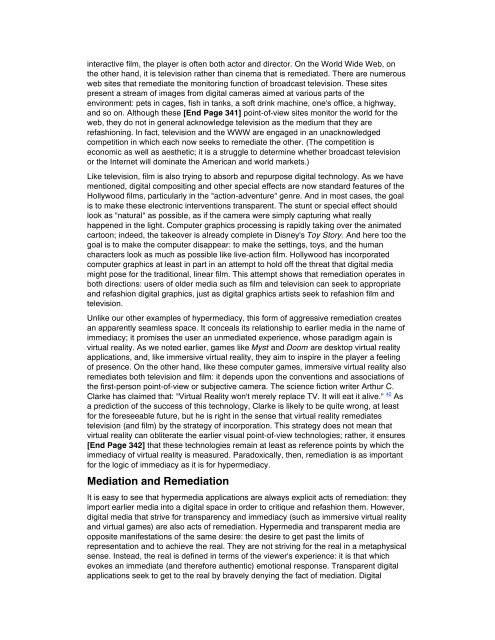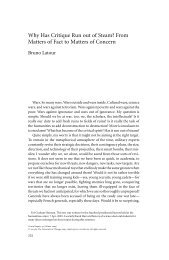Remediation - Dss-edit.com
Remediation - Dss-edit.com
Remediation - Dss-edit.com
You also want an ePaper? Increase the reach of your titles
YUMPU automatically turns print PDFs into web optimized ePapers that Google loves.
interactive film, the player is often both actor and director. On the World Wide Web, on<br />
the other hand, it is television rather than cinema that is remediated. There are numerous<br />
web sites that remediate the monitoring function of broadcast television. These sites<br />
present a stream of images from digital cameras aimed at various parts of the<br />
environment: pets in cages, fish in tanks, a soft drink machine, one's office, a highway,<br />
and so on. Although these [End Page 341] point-of-view sites monitor the world for the<br />
web, they do not in general acknowledge television as the medium that they are<br />
refashioning. In fact, television and the WWW are engaged in an unacknowledged<br />
<strong>com</strong>petition in which each now seeks to remediate the other. (The <strong>com</strong>petition is<br />
economic as well as aesthetic; it is a struggle to determine whether broadcast television<br />
or the Internet will dominate the American and world markets.)<br />
Like television, film is also trying to absorb and repurpose digital technology. As we have<br />
mentioned, digital <strong>com</strong>positing and other special effects are now standard features of the<br />
Hollywood films, particularly in the "action-adventure" genre. And in most cases, the goal<br />
is to make these electronic interventions transparent. The stunt or special effect should<br />
look as "natural" as possible, as if the camera were simply capturing what really<br />
happened in the light. Computer graphics processing is rapidly taking over the animated<br />
cartoon; indeed, the takeover is already <strong>com</strong>plete in Disney's Toy Story. And here too the<br />
goal is to make the <strong>com</strong>puter disappear: to make the settings, toys, and the human<br />
characters look as much as possible like live-action film. Hollywood has incorporated<br />
<strong>com</strong>puter graphics at least in part in an attempt to hold off the threat that digital media<br />
might pose for the traditional, linear film. This attempt shows that remediation operates in<br />
both directions: users of older media such as film and television can seek to appropriate<br />
and refashion digital graphics, just as digital graphics artists seek to refashion film and<br />
television.<br />
Unlike our other examples of hypermediacy, this form of aggressive remediation creates<br />
an apparently seamless space. It conceals its relationship to earlier media in the name of<br />
immediacy; it promises the user an unmediated experience, whose paradigm again is<br />
virtual reality. As we noted earlier, games like Myst and Doom are desktop virtual reality<br />
applications, and, like immersive virtual reality, they aim to inspire in the player a feeling<br />
of presence. On the other hand, like these <strong>com</strong>puter games, immersive virtual reality also<br />
remediates both television and film: it depends upon the conventions and associations of<br />
the first-person point-of-view or subjective camera. The science fiction writer Arthur C.<br />
Clarke has claimed that: "Virtual Reality won't merely replace TV. It will eat it alive." 42 As<br />
a prediction of the success of this technology, Clarke is likely to be quite wrong, at least<br />
for the foreseeable future, but he is right in the sense that virtual reality remediates<br />
television (and film) by the strategy of incorporation. This strategy does not mean that<br />
virtual reality can obliterate the earlier visual point-of-view technologies; rather, it ensures<br />
[End Page 342] that these technologies remain at least as reference points by which the<br />
immediacy of virtual reality is measured. Paradoxically, then, remediation is as important<br />
for the logic of immediacy as it is for hypermediacy.<br />
Mediation and <strong>Remediation</strong><br />
It is easy to see that hypermedia applications are always explicit acts of remediation: they<br />
import earlier media into a digital space in order to critique and refashion them. However,<br />
digital media that strive for transparency and immediacy (such as immersive virtual reality<br />
and virtual games) are also acts of remediation. Hypermedia and transparent media are<br />
opposite manifestations of the same desire: the desire to get past the limits of<br />
representation and to achieve the real. They are not striving for the real in a metaphysical<br />
sense. Instead, the real is defined in terms of the viewer's experience: it is that which<br />
evokes an immediate (and therefore authentic) emotional response. Transparent digital<br />
applications seek to get to the real by bravely denying the fact of mediation. Digital









